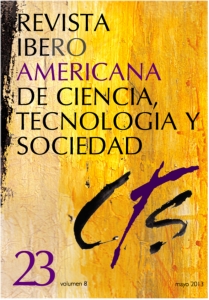Learning to program in Citilab
DOI:
https://doi.org/10.52712/issn.1850-0013-645Keywords:
S4A, ICT, innovation, society, scratch, smalltalk, botsincAbstract
This article aims at compiling the experiences gathered by Citilab in bringing computer programming to the people. Without any prerequisite, anyone can enroll in any of our courses. This is possible mainly thanks to the existence of a very suitable piece of software which was developed with the Smalltalk programming language: Scratch for kids (but not only for them), BotsInc as an introduction to Smalltalk, and also Squeak, a Smalltalk open source implementation that was used in the creation of the software mentioned above and is directed to experienced programmers.
Downloads
References
ABELSON, H. (2001): Structure and Interpretation of Classical Mechanics, MIT Press.
ABELSON, H. y DI SESSA, A. (1986): Turtle Geometry, The Computer as a Medium for Exploring Mathematics, MIT Press.
ABELSON, H. (1996): Structure and Interpretation of Computer Programs, MIT Press.
AIKEN, R. M. (1972): “Experiences and observations on teaching computer programming and simulation concepts to high school students”, SIGCSE ’72: Proceedings of the second SIGCSE technical symposium on Education in computer science, pp. 67–71.
DE CAMPO, L. (1970): “Introducing the computer at a small liberal arts college”. SIGCSE’70: Proceedings of the first SIGCSE technical symposium on Education in computer science, pp. 113–117.
DUCASSE, S. (2008): “Squeak, Aprèn a Programar amb Robots”. Disponible en: https://gforge.inria.fr/frs/download.php/12387/2008-12-13-BotsincCatala.pdf.
DUCASSE, S. (2005): Squeak – Learn Programming with Robots, Apress.
FELDMAN, S. (2005): “A conversation with Alan Kay”, Queue, vol. 2, nº 9, pp. 20–30.
GOLDBERG, A. y ROBSON, D. (1983): Smalltalk-80 — The Language and its Implementation, Reading, MA, Addison-Wesley.
GUPTA, N. (2012): “Learning by creating: Interactive programming for Indian high schools”, IEEE Intl. Conference on Technology Enhanced Education (ICTEE). Disponible en: http://ieeexplore.ieee.org/xpls/abs_all.jsp?arnumber=6208643&tag=1.
MALAN, D. y LEITNER, H. (s/f): “Scratch for budding computer scientists”, 38th SIGCSE technical symposium on Computer science.
MALONEY, J. (2008): “Programming by choice: Urban youth learning programming with Scratch”, 39th SIGCSE technical symposium on Computer science education, pp. 367–371.
NIERSTRASZ, O. (2008): Squeak By Example, Square Bracket Associates.
PAPERT, S. (1993): Mindstorms — Children, Computers and Powerful Ideas, Basic Books.
SIVILOTTI, P. LAUGEL, S. (2008): “Scratching the surface of advanced topics in software engineering: A workshop module for middle school students”, 39th SIGCSE technical symposium on Computer science education, pp. 291–295.
WOLZ, U. (2008): “‘Scratch’ your way to introductory CS”, 39th SIGCSE technical symposium on Computer science education, pp. 298–299.
Downloads
Published
How to Cite
Issue
Section
License
Copyright (c) 2013 https://creativecommons.org/licenses/by-nd/2.5/es/deed.caAll CTS's issues and academic articles are under a CC-BY license.
Since 2007, CTS has provided open and free access to all its contents, including the complete archive of its quarterly edition and the different products presented in its electronic platform. This decision is based on the belief that offering free access to published materials helps to build a greater and better exchange of knowledge.
In turn, for the quarterly edition, CTS allows institutional and thematic repositories, as well as personal web pages, to self-archive articles in their post-print or editorial version, immediately after the publication of the final version of each issue and under the condition that a link to the original source will be incorporated into the self-archive.











